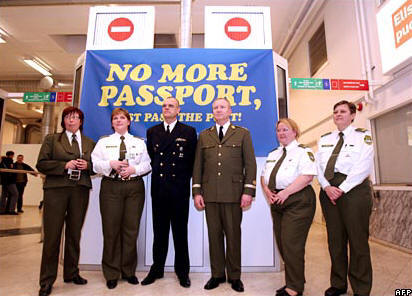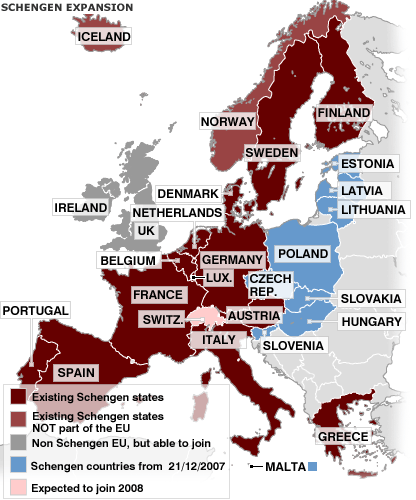The unprecedented enlargement of the Schengen area that took place on 21 December 2007 saw nine additional countries joining the Schengen area, which now encompasses 400 million citizens and 24 countries (22 EU Member States Austria, Belgium, the Czech Republic, Denmark, Estonia, Finland, France, Germany, Greece, Hungary, Italy, Latvia, Lithuania, Luxembourg, Malta, the Netherlands, Poland, Portugal, Slovakia, Slovenia, Spain and Sweden plus the two associated countries Norway and Iceland).
The Schengen Area Treaty was first signed in 1985 between just Germany, France and the Benelux countries in the small Luxembourg border town of Schengen. Since 1999, it has been integrated into EU law and therefore applies to all EU countries (although the UK and Ireland opted to stay out). On 21 December 2007, the Czech Republic, Estonia, Hungary, Latvia, Lithuania, Malta, Poland, Slovakia and Slovenia joined the Schengen area. It is now possible to travel from Malta to the Continent, from the Iberian Peninsula to the Baltic States and from Greece to Finland without border checks.
Becoming a member of the European Union does not mean automatic accession to the Schengen area without internal border checks. Malta became a full member of the European Union from 1st May 2004 but also opted to form part of the Schengen Area Agreement.
The Schengen Agreement removes all controls on persons at internal borders between Member States and harmonises controls at the EUs external borders. This means that visas for entry into Malta will also be a valid permit for entry into the EU (normally, for up to three months). Once a person enters Malta, he or she enjoys freedom of movement within the EU countries that are part of Schengen.

news.bbc.co.uk
Time-line for the abolition of internal borders and creation of a single EU external frontier
14 June 1985: Belgium, Germany, France, Luxembourg and the Netherlands sign the Schengen Agreement.
19 June 1990: the original founders of the Schengen cooperation sign the Convention implementing the Schengen Agreement (Schengen Convention).
26 March 1995: abolition of border control between Belgium, Germany, France, Luxembourg, the Netherlands, Spain and Portugal.
26 October 1997: start of gradual abolition of border control with Italy (completed on 31 March 1998).
1 December 1997: start of gradual abolition of border control with Austria (completed on 31 March 1998).
1 March 2000: abolition of border control with Greece (completed on 26 March 2000).
25 March 2001: abolition of border control with Norway, Iceland, Sweden, Denmark and Finland.
21 December 2007: abolition of control of land and sea borders with the Czech Republic, Estonia, Hungary, Latvia, Lithuania, Malta, Poland, Slovakia and Slovenia (border checks on intra-Schengen flights at airports abolished on 30 March 2008).
For more information about the Malta Residence Scheme, click on the links on the left hand menu of this page.


